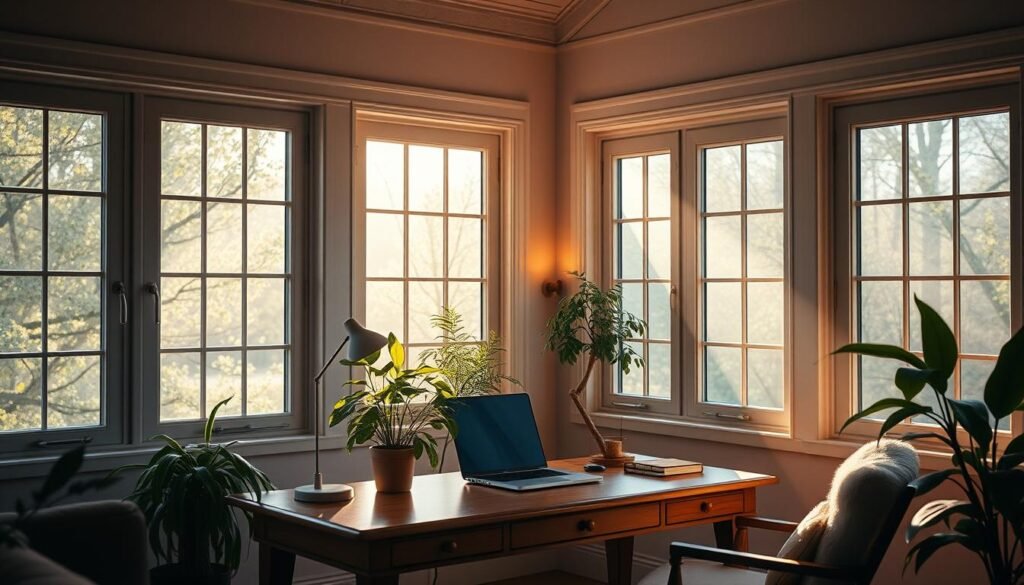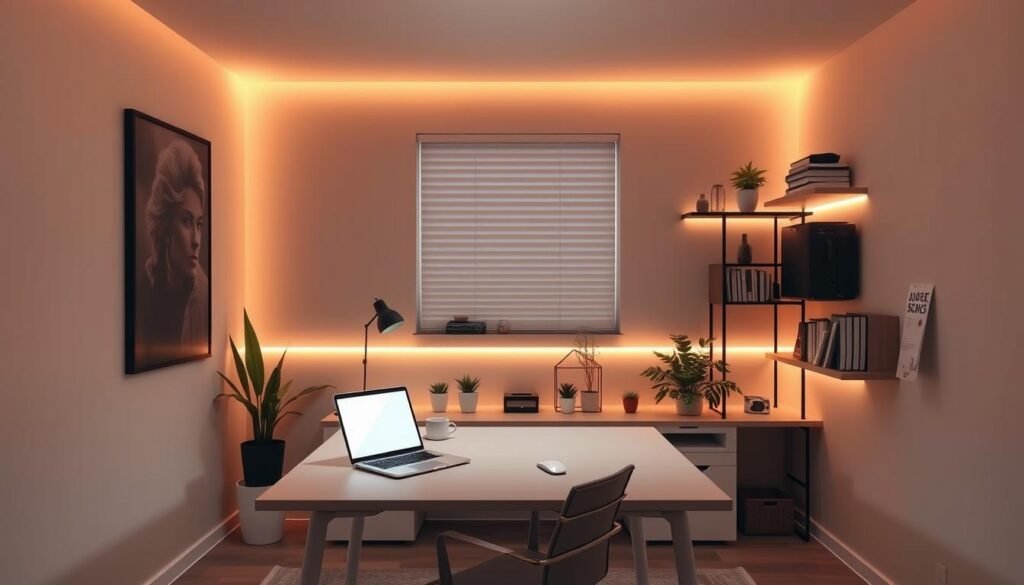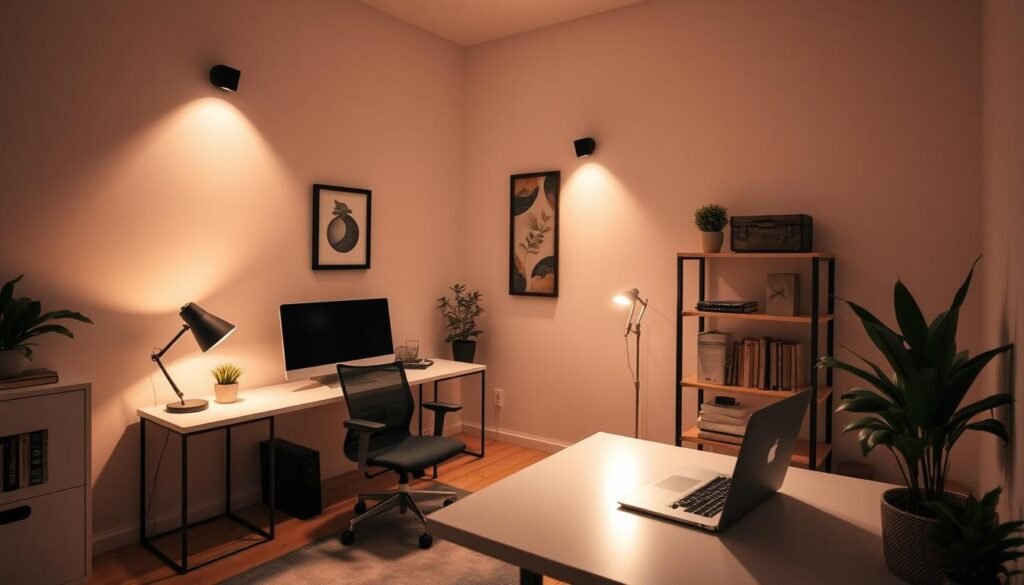Working from home can be tough, especially when it comes to setting up a good workspace. The right lighting is key to feeling good and working well. So, I’m here to share some top tips for lighting up your home office.
Key Takeaways
- Understand the importance of home office lighting for productivity and well-being
- Explore the differences between natural and artificial light in your workspace
- Discover essential lighting solutions for task, ambient, and accent lighting
- Choose the perfect desk lamp to illuminate your workstation
- Leverage LED technology for energy-efficient and adjustable lighting

Understanding the Importance of Home Office Lighting
Good workspace illumination is key to being productive and feeling good in your home office. It affects how well we work, our mood, and our health. Let’s explore how lighting impacts us.
Impact on Productivity and Well-being
Right lighting helps us stay focused and boosts our mood and energy. Research shows it makes us work better, feel less eye strain, and be happier at work. But bad lighting can cause headaches, tiredness, and lower motivation. This affects how well we do our jobs and how we feel overall.
The Science Behind Proper Illumination
Our body’s natural rhythm, or circadian rhythm, is controlled by light. Bright, blue-enriched light during the day wakes us up and improves our thinking. Warm, low-intensity light in the evening helps us relax and sleep better. Finding the right mix of these lights is crucial for a healthy and productive home office.
Knowing how to prevent eye strain and set up the best lighting can make your home office better. It can improve your well-being.
“Proper lighting is not just about function, but also about creating a comfortable and inspiring workspace that supports our cognitive and emotional needs.”
Natural Light vs Artificial Light in Your Workspace
When setting up a home office, the mix of natural and artificial light is key. Knowing the benefits of each can help you find the right balance for your space.
The Allure of Natural Light
Windows and skylights bring in natural home office lighting that changes your work area. Daylight boosts mood, increases productivity, and improves health. Placing your desk near windows can use sunlight to energize your work.
The Role of Artificial Lighting
Artificial light is needed sometimes in a home office. Desk lamps offer focused light for detailed tasks. Ambient lighting adds warmth and invites you in. Choosing the right lights can make your space look good and work well.
| Natural Light | Artificial Light |
|---|---|
| Boosts mood and productivity | Enables focused task lighting |
| Improves overall well-being | Provides ambient lighting for atmosphere |
| Enhances the aesthetics of the space | Ensures adequate, glare-free illumination |
Understanding natural and artificial home office lighting helps create a balanced workspace. It meets your needs and preferences.
“The right balance of natural and artificial light can truly transform a home office, boosting both productivity and well-being.”

Essential Types of Home Office Lighting
Creating a great home office needs careful thought about lighting. There are three main types of lighting: task, ambient, and accent. Each is important for a productive and comfortable space.
Task Lighting Solutions
Task lighting shines on areas where you do focused work, like your desk. It reduces eye strain and improves what you see. Desk lamps, under-cabinet lights, and floor lamps are good for this.
Ambient Lighting Options
Ambient lighting lights up the whole room. It makes the space feel warm and welcoming. Ceiling lights, wall sconces, and recessed lights are common choices for this.
Accent Lighting Choices
Accent lighting draws attention to special parts of your office. It can highlight art, bookshelves, or unique features. Spotlights, track lights, and wall fixtures are great for adding interest.
Using a mix of task, ambient, and accent lighting makes your home office better. It helps you work well and feel good.

Choosing the Perfect Desk Lamp for Your Setup
Choosing the right desk lamp can really improve your home office. Desk lamps are key for task lighting, making your workspace bright and reducing eye strain. Let’s look at what to consider when picking the best desk lamp for you.
Adjustability and Flexibility
Being able to adjust your desk lamp’s height, angle, and brightness is important. Look for lamps that let you position the light where you need it. This flexibility helps you light your workspace just right for your tasks.
Lighting Intensity and Color Temperature
The light’s intensity and color can affect how well you work and feel. Choose a lamp that’s bright enough for your tasks but not too harsh. Also, think about the light’s color. Warmer lights (2700K-3000K) can be calming, while cooler lights (4000K-6500K) help you focus.
Design and Aesthetics
The design of your desk lamp matters too. Pick a lamp that fits your office’s style and decor. This way, your lamp will add to your office’s look and feel.

By thinking about these points, you can find the perfect desk lamp for your home office. The right desk lamp can really help make your workspace better and more productive.
LED Lighting Solutions for Energy Efficiency
In today’s workspace, saving energy is key. LED lights are a top choice for this. They cut down on carbon emissions and make your home office look great. Let’s dive into the amazing benefits of LED lights and how they can change your workspace.
Benefits of LED Technology
LED lights are known for their energy-saving abilities. They use up to 80% less power than old bulbs. This makes them a green choice for your office. Plus, they last a long time, often 25,000 to 50,000 hours, much longer than other bulbs.
Color Temperature Options
LED lights are versatile in color. You can pick from warm, cozy colors to cool, energizing ones. Warm colors, like those between 2700K and 3000K, make your space feel welcoming. Cool colors, from 4000K to 6500K, help you stay focused and productive.
By placing LED lights right, you can make your office both beautiful and functional. Their energy-saving and color-changing abilities make them a great pick for your workspace.

Preventing Eye Strain Through Proper Lighting Design
Working long hours in your home office can be tough on your eyes. The right lighting can help prevent eye strain and keep you focused. Here are some tips to choose the best lighting for your space.
Optimize Desk Lamp Positioning
Getting your desk lamp right is important. Make sure the light hits your work area, not your screen. Adjust the lamp’s height to light up your space evenly.
Manage Ambient Lighting Levels
Match your room’s light with your computer’s brightness. Avoid harsh contrasts to ease eye strain. Use dimmers or adjustable lamps for a steady, comfortable light.
| Lighting Recommendation | Benefit |
|---|---|
| Use task lighting for focused work | Reduces eye fatigue by providing directed, concentrated illumination |
| Incorporate ambient lighting for general space | Prevents eye strain by avoiding stark brightness differences |
| Select the right color temperature for your needs | Warmer tones can be less straining on the eyes than cooler, blue-ish lights |
By using these eye strain prevention tips, you can make your home office better for your eyes. Small changes can help a lot in keeping your eyes comfortable and your work smooth.
Smart Lighting Systems for Home Offices
Smart lighting systems have changed how we light our home offices. They boost productivity and make our workspaces more comfortable and energy-saving.
Voice Control Features
Smart lighting systems work with voice control technology. You can change your dimmable lights and LED lights with just your voice. This makes it easy to adjust the light for calls or focused work.
Automated Scheduling Benefits
These systems also have automated scheduling. You can set them to change the light based on time or your routine. This keeps your office well-lit when you work and saves energy when you’re not there.
“Integrating smart lighting into my home office has been a game-changer. The voice control and automated scheduling features have saved me time and enhanced my overall productivity.”
Smart lighting makes your home office better for work and your health. It’s efficient, comfy, and looks great.

Positioning Your Light Sources Effectively
When it comes to workspace illumination and lighting design for your home office, where you place your lights matters a lot. By placing your lights wisely, you can cut down on glare and shadows. This makes your workspace brighter and more comfortable.
Remember the rule of task lighting. Task lighting shines directly on areas where you work, like your desk. Placing task lights near these spots ensures your area is lit well without shadows or reflections.
It’s also smart to mix task lighting with ambient lighting. Ambient lighting adds a soft glow that makes your space look good and feel cozy. Using floor lamps, wall sconces, or overhead lights can balance the light in your office and ease eye strain.
When setting up your lights, watch out for glare from screens or shiny surfaces. Place your lights so they don’t shine directly on these areas. Using lights that you can adjust or dim helps you get the right light levels.
“Proper lighting design can make a significant difference in the overall productivity and comfort of your home office.”
The aim is to have a balanced and ergonomic lighting setup that boosts your work and comfort. By carefully placing your lights, you can make your home office lighting more efficient and effective.
Color Temperature and Its Effect on Productivity
The color temperature of your workspace lighting greatly affects your productivity and well-being. It’s important to know the difference between warm and cool lighting. This knowledge helps create the best home office environment.
Warm vs. Cool Lighting
Warm lighting has a yellowish or reddish tone, making your space cozy and relaxing. It’s great for tasks that need focus and concentration. It reduces eye strain and fatigue.
Cool lighting, with its blueish hue, energizes and stimulates. It’s perfect for creative and analytical work.
Seasonal Lighting Adjustments
The best lighting changes with the seasons and natural LED lights in your space. In winter, when days are shorter, warm lighting helps fight off the gloom. It keeps your workspace illumination cheerful and productive.
In summer, cool lighting creates a refreshing and focused atmosphere. It complements the brighter natural light.
| Lighting Attribute | Warm Lighting | Cool Lighting |
|---|---|---|
| Color Temperature | 2,700K – 3,000K | 4,000K – 6,500K |
| Effect | Cozy, relaxing | Energizing, stimulating |
| Best for | Focus and concentration | Creative and analytical work |
| Seasonal Preference | Winter | Summer |
“Proper lighting can make a significant difference in your work productivity and overall well-being. Experiment with different color temperatures to find the perfect balance for your home office.”
Budget-Friendly Lighting Upgrades
Upgrading your home office lighting doesn’t have to be expensive. You can make your workspace better and more productive without spending a lot. Just choose wisely and stay within your budget.
Energy-Efficient Bulb Swaps
Swapping old bulbs for energy efficient bulbs is a simple and cheap way to improve your lighting. LED bulbs are now bright, last long, and use less energy. Choose Energy Star-certified bulbs to save even more.
Affordable Desk Lamp Solutions
A good desk lamp can give you the right light for your tasks. You don’t need to spend a lot. Look for lamps that can change brightness and color to fit your needs.
Repurposing Existing Fixtures
- Think about what you can do with your current lights. A few tweaks can make them new again.
- Change old shades or diffusers for a modern look.
- Install dimmers to control your light and save energy.
| Upgrade | Cost-Effective Option | Benefits |
|---|---|---|
| Overhead Lighting | LED Light Panels | Bright, energy-efficient illumination for the entire room |
| Task Lighting | Adjustable desk lamps | Focused light for your workspace, with customizable brightness |
| Accent Lighting | String Lights or Puck Lights | Add ambient glow and visual interest to your home office |
With a few smart, affordable changes, you can make your home office lighting better. You’ll get a more productive and nice-looking space without spending too much.
Dealing with Screen Glare and Reflection
Creating a great home office is more than just the right lights. It’s also about reducing screen glare and reflection. These can cause eye strain and make it hard to see. By tackling these issues, you can make your workspace better for your eyes and work.
Anti-glare Solutions
Anti-glare screens or filters can really help your home office. They soften harsh reflections, making glare less intense. This can prevent eye fatigue and headaches. Also, adjusting your screen’s brightness and contrast can help fight glare, making it easier to see.
Monitor Positioning Tips
Where you put your computer monitor matters a lot. Keep it away from direct light, like windows or overhead lights. This cuts down on glare and reflection. Try different angles and tilts to find the best spot for your monitor. This way, your eyes won’t get tired from glare.

Hello, I’m Jane, founder of Home Vibe Ideas. I’m here to inspire stylish Home Design, modern Smart Living, beautiful Outdoor Spaces, and creative DIY Projects to help you create a home that’s uniquely yours.
Disclosure: This post contains affiliate links. If you click on a link and make a purchase, we may earn a small commission at no additional cost to you. The content on this site was created with the help of AI technology.


